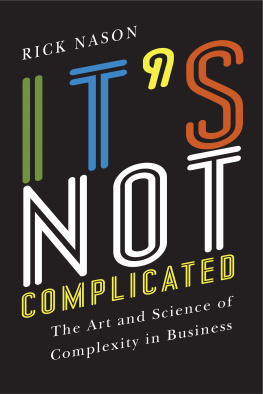Six
Simple
Rules
How to Manage Complexity without Getting Complicated
YVES MORIEUX
PETER TOLLMAN
HARVARD BUSINESS REVIEW PRESS
BOSTON, MASSACHUSETTS
Copyright 2014 The Boston Consulting Group, Inc.
All rights reserved
Printed in the United States of America
10 9 8 7 6 5 4 3 2 1
No part of this publication may be reproduced, stored in or introduced into a retrieval system, or transmitted, in any form, or by any means (electronic, mechanical, photocopying, recording, or otherwise), without the prior permission of the publisher. Requests for permission should be directed to , or mailed to Permissions, Harvard Business School Publishing, 60 Harvard Way, Boston, Massachusetts 02163.
The web addresses referenced in this book were live and correct at the time of the books publication but may be subject to change.
Library of Congress Cataloging-in-Publication Data
Morieux, Yves, 1960
Six simple rules : how to manage complexity without getting complicated / Yves Morieux, Peter Tollman.pages cmISBN 978-1-4221-9055-5 (alk. paper)
1. Complex organizationsManagement. 2. Organizational effectiveness. 3. Organizational behavior. 4. Management. I. Tollman, Peter. II. Title.
HD31.M6292 2014658dc23
2013045502
Contents
Why Managers Need the Six Simple Rules Understand What Your People Do Reinforce Integrators Increase the Total Quantity of Power Increase Reciprocity Extend the Shadow of the Future Reward Those Who Cooperate
Introduction
Why Managers Need the Six Simple Rules
H ow do companies create value and achieve competitive advantage in an age of great complexity? This is a question we constantly ask ourselves as we go about our work of helping chief executives and their leadership teams build successful businesses.
When we reflect on our work with the companies we have helped over the yearsfive hundred or more in all kinds of industries in more than forty countrieswhat we remember most vividly is rarely the specific problem that caused a business leader to call us in. Rather what comes to mind is the peoplean airline maintenance worker, a head of R&D, a hotel receptionist, a sales director, a train driver, a CEOall of whom were facing more or less the same situation. They confronted a challenge that seemed impossible: increased complexity in their business. Well discuss complexity in greater detail further along, but briefly, we mean that companies face an increasing number of performance requirements; the number can be in the range of twenty-five to forty different requirements, far more than twenty or even ten years ago. Often the requirements are contradictory in nature, such as the need to produce goods of high quality that can sell at low prices, or for services to be globally consistent yet also responsive to local demands (see the sidebar The Complexity Challenge and Opportunity).
To meet the challenges of complexity, the people we remember so well had tried applying the best management thinking and following the best practices of the dayincluding, as well see, both structural fixes and people-oriented approachesand those practices had failed to bring them success in their efforts in creating value. They were working hard and, when they failed to achieve the results they wanted, they worked harder. But they didnt have much hope the outcome would be any different. They felt overwhelmed, trapped, and often misunderstood and unsupported by their teams, bosses, and boards.
Whats striking is how poorly served these people were by the conventional wisdom in managementthe management theories, models, and practices developed over the past one hundred years. Instead of helping these people manage the growing complexity of business, all the supposed solutions only seemed to make things worse. There had to be a better way, and through on-the-ground work with these people and their organizations, we have battle tested the approach that we describe in this book. We call this approach smart simplicity and it hinges on the six simple rules.
Yves comes at the issue as director of the Institute for Organization at The Boston Consulting Group (BCG), where he brings economics and social sciences to bear on the strategic and organizational challenges of companies and their executive teamsespecially as they relate to complexity. Yves formulated the smart simplicity approach to managing complexity, based on his background in research and theoretical inquiry, as well as his extensive work with clients in the United States, Europe, and Asia-Pacific. As head of the firms People and Organization Practice in North America, Peter has partnered with Yves to implement the six rules of the smart simplicity approach, drawing on his long experience working with some of the worlds most prominent companies.
Through our client work and continued research, we have continuously refined the rules so that they offer a theoretical framework and a set of practicable management tools. We are actively working together, and with our BCG colleagues, to successfully apply the simple ruleshelping companies around the world grow, create enduring value, and achieve competitive advantage.
How Complexity Leads to Complicatedness
To understand the power of the simple rules and why they are so essential in business, lets start by defining the problem. Today, companies have to deal with greater business complexity than ever before. This complexity arises from the requirements companies must meet to create value for their stakeholders. These requirements have become more numerous, are changing faster, and, whats more, are often in conflict with one another. We have actually measured this evolution and created what we call the BCG Complexity Index. It shows that business complexity has multiplied sixfold since 1955.
THE COMPLEXITY CHALLENGE AND OPPORTUNITY Performing on Everything for Everyone
The BCG Institute for Organization created the Complexity Index by tracking the evolution of the number of performance requirements at a representative sample of companies in the United States and Europe over a period of fifty-five yearsfrom 1955 (the year the Fortune 500 list was created) through 2010. In 1955, companies typically committed to between four and seven performance imperatives; today they commit to between twenty-five and forty.
Between 15 percent and 50 percent of those performance requirements are contradictory. Around 1955, hardly any were. Companies currently may have to offer high-quality products and sell them at rock-bottom prices; goods have to be innovative and also produced efficiently; supply chains must be fast and reliable; service must be globally consistent and, at the same time, highly responsive locally. When a company is able to reconcile valuable yet contradictory requirements, it breaks a compromise and, in so doing, unleashes new value for customers. This new value creates advantage and fuels profitable growth.
We see two important causes for the growth of complexity. First, shifting trade barriers and advances in technology have provided customers with an abundance of choices. With so many options available, customers are harder to please than ever and less willing to accept compromises .
A second factor is an increase in the number of relevant stakeholders. Companies must answer to customers, shareholders, and employees as well as to any number of political, regulatory, and compliance authorities. Each of these groups has specific demands, and it has become penalizing for companies to satisfy one at the expense of any other.
Some observers think increasing business complexity is the problem. We disagree. We believe that while complexity brings immense challenges, it also offers a tremendous opportunity for companies. Increasingly, the winners in todays business environment are those companies that know how to leverage complexity and exploit it to create competitive advantage.
Next page












